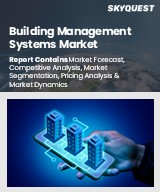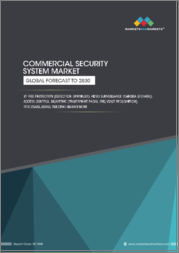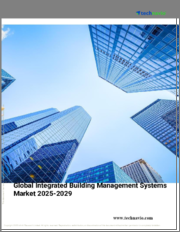
|
시장보고서
상품코드
1530774
빌딩 관리 시스템 시장 예측(-2030년) : 시스템 유형별, 컴포넌트 유형별, 도입 유형별, 용도별, 최종사용자별, 지역별 세계 분석Building Management Systems Market Forecasts to 2030 - Global Analysis By System Type, Component Type, Deployment Type, Application, End User and By Geography |
||||||
Stratistics MRC에 따르면 세계의 빌딩 관리 시스템 시장은 2024년에 227억 달러를 차지하고 예측 기간 중 CAGR은 18.7%로 성장하며, 2030년에는 637억 달러에 달할 전망입니다.
빌딩 관리 시스템(BMS)은 HVAC, 조명, 보안 시스템 등 건물의 기계 및 전기 설비를 모니터링하고 제어하기 위해 설계된 통합 시스템으로, 실시간 데이터 분석 및 자동화를 통해 운영 효율성을 최적화하고 편안함을 개선하며 에너지를 절약할 수 있도록 도와준다, 센서, 컨트롤러, 소프트웨어를 활용하여 건물 기능을 관리하고, 유지보수를 위한 경고를 제공하며, 원격 액세스를 용이하게 합니다. 다양한 빌딩 시스템을 통합함으로써 BMS는 건물 전체의 성능과 거주자 만족도를 향상시킵니다.
도시화 진전과 인프라 구축
도시화 발전과 인프라 구축이 시장을 주도하고 있습니다. 도시가 확장되고 현대화됨에 따라 건물 운영을 관리하기 위한 효율적이고 자동화된 솔루션에 대한 수요가 증가하고 있습니다. 에너지 사용을 최적화하고, 보안을 강화하며, 거주자의 편안함을 향상시키는 이러한 기술은 신규 및 기존 건물에 필수적인 요소로 자리 잡고 있습니다. 이러한 추세는 스마트 시티 구상과 지속가능한 도시 성장을 지원하는 첨단 확장형 솔루션을 요구하는 그린빌딩 표준에 의해 더욱 가속화되고 있습니다.
복잡성과 통합의 과제
빌딩 관리 시스템(BMS)은 다양한 기술 및 프로토콜이 관련되어 있으므로 복잡성과 통합의 어려움에 직면해 있으며, HVAC, 조명, 보안, 에너지 관리 등 다양한 하위 시스템을 통합하기 위해서는 원활한 통신과 상호 운용성이 필요합니다. 실시간 데이터 처리와 시스템 커스터마이징의 필요성도 복잡성을 가중시키고 있습니다. 또한 레거시 시스템과의 호환성을 보장하고 사이버 보안 위험에 대처하는 것은 통합 작업을 더욱 복잡하게 만듭니다.
건물 성능 향상
시장에서의 건물 성능 향상은 효율성, 안전성 및 지속가능성을 향상시키는 기술 발전에 의해 주도되고 있습니다. 최신 BMS는 첨단 센서, 실시간 데이터 분석 및 자동 제어 시스템을 통합하여 에너지 사용을 최적화하고 운영 비용을 절감하며 거주자의 편안함을 향상시킵니다. 이러한 시스템은 사전 예방적 유지보수와 다른 빌딩 시스템과의 원활한 통합을 촉진하여 서비스 수명과 운영 효율성을 향상시킵니다.
숙련된 전문 인력 부족
시장은 숙련된 전문가 부족이라는 큰 문제에 직면해 있습니다. 기술이 발전함에 따라 정교한 솔루션의 설계, 구현 및 유지보수에 대한 전문 지식에 대한 수요가 증가하고 있습니다. 그러나 최신 시스템이 요구하는 복잡성과 통합에 대응할 수 있는 자격을 갖춘 인력은 한정되어 있습니다. 이러한 기술 격차는 기술 혁신과 효율성을 저해하고, 첨단 빌딩 관리 기술 도입 지연과 비용 증가로 이어질 수 있습니다.
COVID-19의 영향 :
COVID-19 팬데믹은 원격 모니터링 및 관리 기술의 채택을 가속화하여 시장에 큰 영향을 미쳤습니다. 건물의 안전 및 보건 조치를 강화해야 할 필요성으로 인해 실시간 데이터 수집 및 분석이 가능한 고급 솔루션에 대한 수요가 증가했습니다. 또한 에너지 효율과 비용 절감에 대한 관심은 스마트 빌딩 기술에 대한 투자를 촉진했습니다. 그러나 초기에는 공급망 혼란과 경제의 불확실성으로 인해 시장 성장에 걸림돌로 작용했습니다.
조명 제어 분야는 예측 기간 중 가장 큰 분야가 될 것으로 예상됩니다.
조명 제어는 예측 기간 중 최대치를 기록할 것으로 예상됩니다. 여기에는 점유율, 일조량, 시간대에 따른 조명 자동 제어가 포함됩니다. 고급 시스템은 센서, 조광기 및 프로그래밍 가능한 제어를 통합하여 조명을 최적화하고 조명기구의 수명을 연장합니다. 이 부문은 또한 종합적인 건물 관리를 위해 다른 컴포넌트와의 통합을 지원하여 상업용 및 주거용 건물의 지속가능성 목표와 비용 절감에 기여합니다.
예측 기간 중 주택 부문이 가장 높은 CAGR을 보일 것으로 예상됩니다.
예측 기간 중 주택 부문은 가장 높은 CAGR을 나타낼 것으로 예상됩니다. 주거용 BMS 솔루션에는 스마트 온도 조절기, 조명 제어 시스템, 보안 관리 등이 포함되며, 모두 쾌적성을 최적화하고 에너지 소비를 줄이며 안전성을 향상시키기 위해 설계되었습니다. 이러한 시스템은 다양한 기술을 통합하여 스마트폰이나 태블릿을 통해 주택 소유자에게 원격 모니터링 및 제어 기능을 제공합니다. 스마트홈과 에너지 효율이 높은 솔루션에 대한 수요가 증가함에 따라 이 분야의 기술 혁신이 가속화되고 있습니다.
가장 큰 점유율을 차지하는 지역
북미는 에너지 효율이 높은 솔루션과 스마트 빌딩 기술에 대한 수요 증가로 인해 예측 기간 중 가장 큰 시장 점유율을 차지할 것으로 예상됩니다. 주요 촉진요인으로는 엄격한 에너지 규제, IoT의 발전, 지속가능성에 대한 인식 증가 등이 있습니다. 주요 시장으로는 미국과 캐나다가 있으며, 상업 및 주거 부문은 에너지 사용 최적화, 보안 강화, 운영 효율성 향상을 위해 BMS를 도입하고 있습니다.
CAGR이 가장 높은 지역 :
아시아태평양은 예측 기간 중 가장 높은 CAGR을 나타낼 것으로 예상됩니다. 급속한 도시화와 인프라 프로젝트 확대로 인해 신축 및 기존 건물에 대한 고급 솔루션에 대한 수요가 증가하고 있으며, IoT, AI, 머신러닝 혁신으로 기능이 강화되어 건물 소유주와 관리자에게 더욱 매력적으로 다가서고 있습니다. 스마트 시티 프로젝트를 추진하고 건물 인프라를 개선하기 위한 정부 구상과 인센티브가 이러한 성장을 지원하고 있습니다.
무료 커스터마이즈 제공
본 리포트를 구독하는 고객은 아래의 무료 커스터마이즈 옵션 중 하나를 이용할 수 있습니다. :
- 기업 개요
- 추가 시장 기업의 종합적 프로파일링(최대 3사)
- 주요 기업의 SWOT 분석(최대 3사)
- 지역 세분화
- 고객의 관심에 따른 주요 국가의 시장 추산·예측·CAGR(주 : 타당성 확인에 따라 다름)
- 경쟁 벤치마킹
- 제품 포트폴리오, 지역적 프레즌스, 전략적 제휴에 기반한 주요 기업의 벤치마킹
목차
제1장 개요
제2장 서문
- 개요
- 이해관계자
- 조사 범위
- 조사 방법
- 데이터 마이닝
- 데이터 분석
- 데이터 검증
- 조사 어프로치
- 조사 정보원
- 1차 조사 정보원
- 2차 조사 정보원
- 전제조건
제3장 시장 동향 분석
- 촉진요인
- 억제요인
- 기회
- 위협
- 용도 분석
- 최종사용자 분석
- 신흥 시장
- COVID-19의 영향
제4장 Porter's Five Forces 분석
- 공급 기업의 교섭력
- 바이어의 교섭력
- 대체품의 위협
- 신규 진출업체의 위협
- 경쟁 기업 간 경쟁 관계
제5장 세계의 빌딩 관리 시스템 시장 : 시스템 유형별
- 화재와 안전
- 에너지 관리
- 보안과 액세스 제어
- 스마트 빌딩 통합
- 시설 관리 시스템
- 긴급 관리
- 기타 시스템 유형
제6장 세계의 빌딩 관리 시스템 시장 : 컴포넌트 유형별
- 하드웨어
- 컨트롤러
- 센서
- 액추에이터
- 소프트웨어
- 시설 관리 소프트웨어
- 보안 관리 소프트웨어
- 에너지 관리 소프트웨어
- 긴급 관리 소프트웨어
- 서비스
- 전문 서비스
- 매니지드 서비스
제7장 세계의 빌딩 관리 시스템 시장 : 도입 유형별
- 온프레미스
- 클라우드 기반
제8장 세계의 빌딩 관리 시스템 시장 : 용도별
- 조명 제어
- 보안과 액세스 제어
- 에너지 관리
- 피난 시스템
- 기타 용도
제9장 세계의 빌딩 관리 시스템 시장 : 최종사용자별
- 상업
- 주택
- 산업
- 정부
- 기타 최종사용자
제10장 세계의 빌딩 관리 시스템 시장 : 지역별
- 북미
- 미국
- 캐나다
- 멕시코
- 유럽
- 독일
- 영국
- 이탈리아
- 프랑스
- 스페인
- 기타 유럽
- 아시아태평양
- 일본
- 중국
- 인도
- 호주
- 뉴질랜드
- 한국
- 기타 아시아태평양
- 남미
- 아르헨티나
- 브라질
- 칠레
- 기타 남미
- 중동 및 아프리카
- 사우디아라비아
- 아랍에미리트
- 카타르
- 남아프리카공화국
- 기타 중동 및 아프리카
제11장 주요 발전
- 계약, 파트너십, 협업, 합병사업
- 인수와 합병
- 신제품 발매
- 사업 확대
- 기타 주요 전략
제12장 기업 프로파일링
- Johnson Controls International plc
- Schneider Electric SE
- Honeywell International Inc.
- Siemens AG
- Panasonic Corporation
- Bosch Building Technologies
- Crestron Electronics, Inc.
- Lutron Electronics Co., Inc.
- Daintree Networks
- Automated Logic Corporation
- ABB Ltd.
- Delta Controls
- KMC Controls
- Eaton Corporation plc
- Danaher Corporation
- Rockwell Automation
According to Stratistics MRC, the Global Building Management Systems Market is accounted for $22.7 billion in 2024 and is expected to reach $63.7 billion by 2030 growing at a CAGR of 18.7% during the forecast period. Building Management Systems (BMS) are integrated systems designed to monitor and control a building's mechanical and electrical equipment, such as HVAC, lighting, and security systems. They optimize operational efficiency, enhance comfort, and ensure energy savings through real-time data analysis and automation. BMS leverage sensors, controllers, and software to manage building functions, provide alerts for maintenance, and facilitate remote access. By integrating various building systems, BMS improve overall building performance and occupant satisfaction.
Market Dynamics:
Driver:
Growing urbanization and infrastructure development
Growing urbanization and infrastructure development are significantly driving the market. As cities expand and modernize, there is an increasing demand for efficient and automated solutions to manage building operations. These technologies, which optimize energy usage, enhance security, and improve occupant comfort, are becoming integral to new and existing structures. This trend is further fueled by smart city initiatives and green building standards, pushing for advanced, scalable solutions that support sustainable urban growth.
Restraint:
Complexity and integration challenges
Building Management Systems (BMS) face complexity and integration challenges due to the diverse range of technologies and protocols involved. Integrating various subsystems, such as HVAC, lighting, security, and energy management, requires seamless communication and interoperability. The need for real-time data processing and system customization adds to the complexity. Additionally, ensuring compatibility with legacy systems and addressing cybersecurity risks further complicate integration efforts.
Opportunity:
Improved building performance
Improved building performance in the market is driven by advancements in technology, which enhance efficiency, safety, and sustainability. Modern BMS integrate advanced sensors, real-time data analytics, and automated control systems to optimize energy use, reduce operational costs, and improve occupant comfort. These systems facilitate proactive maintenance and seamless integration with other building systems, leading to increased longevity and operational efficiency.
Threat:
Lack of skilled professionals
The market faces a significant challenge due to a shortage of skilled professionals. As technology advances, the demand for expertise in designing, implementing, and maintaining sophisticated solutions grows. However, there is a limited pool of qualified individuals capable of handling the complexity and integration required by modern systems. This gap in skills hampers innovation and efficiency, leading to potential delays and increased costs in deploying advanced building management technologies.
Covid-19 Impact:
The COVID-19 pandemic significantly impacted the market by accelerating the adoption of remote monitoring and management technologies. The need for enhanced health and safety measures in buildings led to increased demand for advanced solutions that enable real-time data collection and analysis. Additionally, the focus on energy efficiency and cost reduction drove investments in smart building technologies. However, supply chain disruptions and economic uncertainties initially hampered market growth during the pandemic.
The lighting control segment is expected to be the largest during the forecast period
The lighting control is expected to be the largest during the forecast period. It involves automated regulation of lighting based on occupancy, daylight levels, and time-of-day schedules. Advanced systems integrate sensors, dimmers, and programmable controls to optimize illumination and extend the lifespan of lighting fixtures. This segment also supports integration with other components for comprehensive building management, contributing to sustainability goals and cost savings in commercial and residential properties.
The residential segment is expected to have the highest CAGR during the forecast period
The residential segment is expected to have the highest CAGR during the forecast period. BMS solutions for residential buildings include smart thermostats, lighting control systems, and security management, all designed to optimize comfort, reduce energy consumption, and improve safety. These systems integrate various technologies to provide homeowners with remote monitoring and control capabilities through smartphones and tablets. The growing demand for smart homes and energy-efficient solutions is driving innovation in this segment.
Region with largest share:
North America is projected to hold the largest market share during the forecast period due to increasing demand for energy-efficient solutions and smart building technologies. Key drivers include stringent energy regulations, advancements in IoT, and rising awareness of sustainability. Major markets include the U.S. and Canada, where commercial and residential sectors are adopting BMS to optimize energy use, enhance security, and improve operational efficiency.
Region with highest CAGR:
Asia Pacific is projected to hold the highest CAGR over the forecast period. Rapid urbanization and expanding infrastructure projects are increasing the demand for advanced solutions in new and existing buildings. Innovations in IoT, AI, and machine learning are enhancing the capabilities, making them more attractive to building owners and managers. Government initiatives and incentives aimed at promoting smart city projects and improving building infrastructure are supporting the expansion.
Key players in the market
Some of the key players in Building Management Systems market include Johnson Controls International plc, Schneider Electric SE, Honeywell International Inc., Siemens AG, Panasonic Corporation, Bosch Building Technologies, Crestron Electronics, Inc., Lutron Electronics Co., Inc., Daintree Networks, Automated Logic Corporation, ABB Ltd., Delta Controls, KMC Controls, Eaton Corporation plc, , Danaher Corporation and Rockwell Automation.
Key Developments:
In May 2024, Siemens unveiled its latest Gridscale X offering, LV Management, at Eurelectric's Power Summit. Embedded with crucial capabilities to actively control the low voltage grid, this represents the first step towards unlocking grid flexibility at scale across planning and operations.
In April 2024, Schneider Electric announced a new partnership with IPConfigure, a leading managed service provider of business security, to integrate cutting-edge video surveillance solutions into Schneider Electric's EcoStruxure(TM) Buildings platform.
System Types Covered:
- Fire and Safety
- Energy Management
- Security and Access Control
- Smart Building Integration
- Facility Management System
- Emergency Management
- Other System Types
Component Types Covered:
- Hardware
- Software
- Service
Deployment Types Covered:
- On-Premises
- Cloud-Based
Applications Covered:
- Lighting Control
- Security and Access Control
- Energy Management
- Evacuation Systems
- Other Applications
End Users Covered:
- Commercial
- Residential
- Industrial
- Government
- Other End Users
Regions Covered:
- North America
- US
- Canada
- Mexico
- Europe
- Germany
- UK
- Italy
- France
- Spain
- Rest of Europe
- Asia Pacific
- Japan
- China
- India
- Australia
- New Zealand
- South Korea
- Rest of Asia Pacific
- South America
- Argentina
- Brazil
- Chile
- Rest of South America
- Middle East & Africa
- Saudi Arabia
- UAE
- Qatar
- South Africa
- Rest of Middle East & Africa
What our report offers:
- Market share assessments for the regional and country-level segments
- Strategic recommendations for the new entrants
- Covers Market data for the years 2022, 2023, 2024, 2026, and 2030
- Market Trends (Drivers, Constraints, Opportunities, Threats, Challenges, Investment Opportunities, and recommendations)
- Strategic recommendations in key business segments based on the market estimations
- Competitive landscaping mapping the key common trends
- Company profiling with detailed strategies, financials, and recent developments
- Supply chain trends mapping the latest technological advancements
Free Customization Offerings:
All the customers of this report will be entitled to receive one of the following free customization options:
- Company Profiling
- Comprehensive profiling of additional market players (up to 3)
- SWOT Analysis of key players (up to 3)
- Regional Segmentation
- Market estimations, Forecasts and CAGR of any prominent country as per the client's interest (Note: Depends on feasibility check)
- Competitive Benchmarking
- Benchmarking of key players based on product portfolio, geographical presence, and strategic alliances
Table of Contents
1 Executive Summary
2 Preface
- 2.1 Abstract
- 2.2 Stake Holders
- 2.3 Research Scope
- 2.4 Research Methodology
- 2.4.1 Data Mining
- 2.4.2 Data Analysis
- 2.4.3 Data Validation
- 2.4.4 Research Approach
- 2.5 Research Sources
- 2.5.1 Primary Research Sources
- 2.5.2 Secondary Research Sources
- 2.5.3 Assumptions
3 Market Trend Analysis
- 3.1 Introduction
- 3.2 Drivers
- 3.3 Restraints
- 3.4 Opportunities
- 3.5 Threats
- 3.6 Application Analysis
- 3.7 End User Analysis
- 3.8 Emerging Markets
- 3.9 Impact of Covid-19
4 Porters Five Force Analysis
- 4.1 Bargaining power of suppliers
- 4.2 Bargaining power of buyers
- 4.3 Threat of substitutes
- 4.4 Threat of new entrants
- 4.5 Competitive rivalry
5 Global Building Management Systems Market, By System Type
- 5.1 Introduction
- 5.2 Fire and Safety
- 5.3 Energy Management
- 5.4 Security and Access Control
- 5.5 Smart Building Integration
- 5.6 Facility Management System
- 5.7 Emergency Management
- 5.8 Other System Types
6 Global Building Management Systems Market, By Component Type
- 6.1 Introduction
- 6.2 Hardware
- 6.2.1 Controllers
- 6.2.2 Sensors
- 6.2.3 Actuators
- 6.3 Software
- 6.3.1 Facility Management Software
- 6.3.2 Security Management Software
- 6.3.3 Energy Management Software
- 6.3.4 Emergency Management Software
- 6.4 Service
- 6.4.1 Professional Services
- 6.4.2 Managed Services
7 Global Building Management Systems Market, By Deployment Type
- 7.1 Introduction
- 7.2 On-Premises
- 7.3 Cloud-Based
8 Global Building Management Systems Market, By Application
- 8.1 Introduction
- 8.2 Lighting Control
- 8.3 Security and Access Control
- 8.4 Energy Management
- 8.5 Evacuation Systems
- 8.6 Other Applications
9 Global Building Management Systems Market, By End User
- 9.1 Introduction
- 9.2 Commercial
- 9.3 Residential
- 9.4 Industrial
- 9.5 Government
- 9.6 Other End Users
10 Global Building Management Systems Market, By Geography
- 10.1 Introduction
- 10.2 North America
- 10.2.1 US
- 10.2.2 Canada
- 10.2.3 Mexico
- 10.3 Europe
- 10.3.1 Germany
- 10.3.2 UK
- 10.3.3 Italy
- 10.3.4 France
- 10.3.5 Spain
- 10.3.6 Rest of Europe
- 10.4 Asia Pacific
- 10.4.1 Japan
- 10.4.2 China
- 10.4.3 India
- 10.4.4 Australia
- 10.4.5 New Zealand
- 10.4.6 South Korea
- 10.4.7 Rest of Asia Pacific
- 10.5 South America
- 10.5.1 Argentina
- 10.5.2 Brazil
- 10.5.3 Chile
- 10.5.4 Rest of South America
- 10.6 Middle East & Africa
- 10.6.1 Saudi Arabia
- 10.6.2 UAE
- 10.6.3 Qatar
- 10.6.4 South Africa
- 11.6.5 Rest of Middle East & Africa
11 Key Developments
- 11.1 Agreements, Partnerships, Collaborations and Joint Ventures
- 11.2 Acquisitions & Mergers
- 11.3 New Product Launch
- 11.4 Expansions
- 11.5 Other Key Strategies
12 Company Profiling
- 12.1 Johnson Controls International plc
- 12.2 Schneider Electric SE
- 12.3 Honeywell International Inc.
- 12.4 Siemens AG
- 12.5 Panasonic Corporation
- 12.6 Bosch Building Technologies
- 12.7 Crestron Electronics, Inc.
- 12.8 Lutron Electronics Co., Inc.
- 12.9 Daintree Networks
- 12.10 Automated Logic Corporation
- 12.11 ABB Ltd.
- 12.12 Delta Controls
- 12.13 KMC Controls
- 12.14 Eaton Corporation plc
- 12.15 Danaher Corporation
- 12.16 Rockwell Automation



















